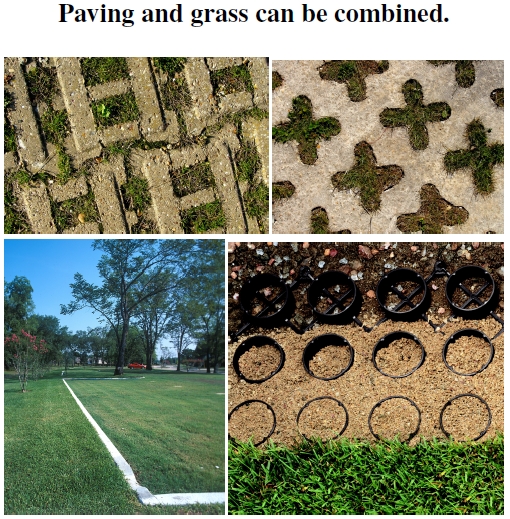2.18 Pervious Paving
Figure 2.18: Vehicles need sturdy parking surfaces, implying high thermal mass, and driving on grass lawns compacts the ground and kills the vegetation. Despite the conflict, parking can coexist with lawns. At top are two examples of old, low-tech grassy paving surfaces, one using bricks and the other using holes (photos by Paula Bailey). In both cases, the cement supports the vehicle, and the not-quite-filled holes protect the vegetation from compaction. The bottom photos show an example of modern grassy paving with a plastic substructure providing the vehicular support (photos by Invisible Structures, Inc.). The modern system has very little thermal mass.
Grassy paving (see Figure 2.18) satisfies many needs simultaneously. Its permeability allows water to pass through, reducing stormwater runoff into retention ponds, infiltration trenches, and streams. Filtration at the parking lot source reduces downstream needs for water treatment, particularly when the stormwater becomes drinking water.[56] Reducing stormwater pollution reduces problems with urban streams, including the less abundant and lower diversity of both macroinvertebrates and fish (see Figure 1.10). These problems arise directly from so much stormwater being efficiently and rapidly transported from impermeable surfaces and into stormwater systems, which usually empty directly into urban streams.[57] Grassy paving would, at worst, slow down this transport and, at best, eliminate most runoff and pollutants during light rains.
Impermeable, paved surfaces also reduce on-site water retention, reducing water availability to trees and other vegetation. Grassy paving would increase water infiltration, recharging soil moisture levels, helping trees grow shadier. As we know, grass cools the air through transpiration (Figure 2.16), but the water has to stick around to be transpired. Grassy paving helps solve these problems, while solid, impervious pavement enhances them.
Shade from parking lot trees becomes less important as more and more grass in grassy paving replaces the impermeable surfaces more and more. Certainly, drought conditions would wreak havoc with so much grass: I imagine parking lots of brown by August in Durham, North Carolina, but even brown grassy paving is prettier than hot and dirty asphalt. Other times of the year, however, all those unused parking spaces (see Figure 2.12) might turn green, giving more of the city a pleasant, park-like look that people could enjoy (see Figure 5.9). Grassy paving also demands the right soil. When Durham’s soils become wet and saturated, they act like a lump of wet clay. Grassy paving on a lump of wet clay might be too squishy for parking cars.
Let’s not forget that grassy paving, being partly alive, needs consistent upkeep, perhaps killing tree seedlings as they recruit into the grass, and some watering during droughts. This maintenance could be costly for a small business, whereas the public gains most of the citywide air and water quality benefits; perhaps some cost-sharing measures could be worked out.
—————————–
[56]Brattebo and Booth (2003) studied permeable paving’s water retention and pollutant filtering abilities over several years, finding extremely favorable results.
[57]Walsh et al. (2005a) describe negative consequences on urban streams from paving.
